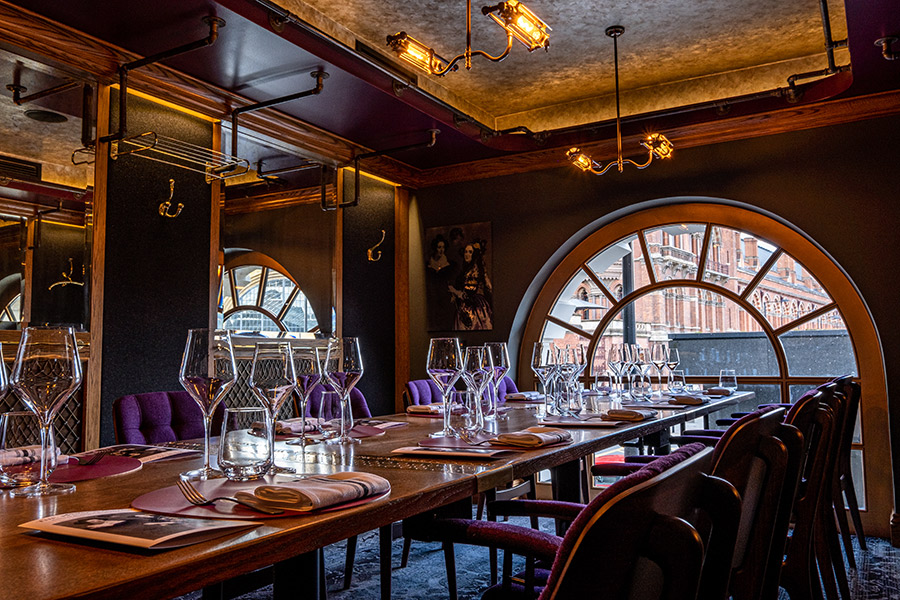Opposite Finsbury Park and only a short tube ride from the centre of London, this establishment…
Finsbury Park to Alexandra Park

5 miles (8kms)
About the walk
Much of this walk follows the former Finsbury Park to Alexandra Palace Railway Line. The railway, which opened in 1867, initially ran between Finsbury Park and Highgate before being extended in 1873 to take people to the newly opened Alexandra Palace; in its heyday the line carried 60,000 passengers on one Whit Monday. Its demise was due to the advent of electric trains and the opening of the Hampstead to Highgate tube. Ironically, in 1954, when the last passenger train ran, it was lengthened from two to eight carriages to meet public demand. Freight continued to use the line until its complete closure in 1971.
In 1984 the trackbed was converted into a 4.5-mile (7.2km) linear walk that alternates between running along the top of an embankment and through the deep, wooded cuttings of the original railway. It is London’s longest statutory Local Nature Reserve and, although King’s Cross at one point is a mere 3 miles (4.8km) further south, you’ll feel totally detached from the bustle of urban life. A remarkable range of trees line your way – oak, ash, birch, cherry, apple, holly, rowan, sycamore and yew – and 22 species of butterfly have been counted along the route.
Memories of its railway related past are continually present, with the route passing over bridges and through tunnels, where the work of graffiti artists is very much in evidence and, at one stage, you’ll even find yourself passing between the platforms of a disused railway station.
Where nature meets urban
Having passed through two ancient woodlands, Queen’s Wood and Highgate Wood, you rejoin the course of the railway and enjoy some truly breathtaking views down over the London skyline below. The Gherkin, the Shard, and Canary Wharf can all be seen along with the Olympic Park.
The walk ends alongside Alexandra Palace, constructed as 'The People’s Palace' in 1873 and from where, in 1936, the world’s first 'high definition' television service was broadcast by the BBC. By this time it had become known affectionately as 'Ally Pally,' a nickname that was reputedly bestowed on it by Gracie Fields. If you still have the energy after your walk, you might wish to visit the ice rink that was opened here in 1990, before taking a bus back to the start point.
Walk directions
Exit left out of the station’s main entrance, cross Stroud Green Road and enter Finsbury Park, to the left of a large silver bicycle sign. Go left at the solitary black post, and veer left along the asphalt path with the railway to your left. At a T-junction turn left and cross a footbridge over the railway.
Turn sharp right to join the Parkland Walk along the disused railway track that once connected Finsbury Park with Alexandra Palace. Continue for a further 1.5 miles (2.4km) along this attractive pathway, a veritable green corridor that crosses bridges and goes under tunnels; at one point the route passes between former station platforms.
Eventually, you veer left up a path lined with wooden posts that leads to a road. Turn right out of the gate, right at The Boogaloo pub and right again, into Shepherds Hill. On the opposite side of the road, turn left immediately in front of Highgate Library and follow the track that descends to Priory Gardens road. Turn right and, after about 250yds (229m) between houses Nos. 8 and 10, turn down an alleyway, which leads to the 50-acre (20ha) Queen's Wood. Take the left fork and climb steeply through the wood. Follow the Capital Ring sign at the next fork and keep straight on, crossing Queen's Wood Road. Keep straight ahead, following the Capital Ring path. The route swings to the right and descends gradually through this woodland that is so dense and ancient that Goldilocks wouldn’t look out of place here.
When you get to the former wood-keeper’s cottage (now a cafe) bear left to Muswell Hill Road. Cross at the traffic lights and enter Highgate Wood by its New Gate entrance. Take the path on the right-hand side and continue parallel to the road. After two more gates leave via the Cranley Gate. Cross the road, turn right into Cranley Gardens and, almost immediately, take the path on the left.
At the bottom of the steps turn right to rejoin the Parkland Walk railway path. Continue and, just past the first bridge, you can enjoy a breathtaking panoramic view of the London skyline, including (to the right) Docklands, the Gherkin, the Shard and the Olympic Park. Straight ahead of you is the mast in Alexandra Park.
Go through an underpass and a covered walkway into Alexandra Park. Follow the path straight ahead, past the Grove Café and follow the path as it swings right; go past six benches and turn left to leave the park by the barrier. Cross the road on the right to catch the W3 bus back to Finsbury Park bus station (a 15-minute journey).
Additional information
Mainly gravel paths
Green corridor through built-up areas of North London
No particular problems
OS Explorer 173 London North
Highgate Park
WALKING IN SAFETY
Read our tips to look after yourself and the environment when following this walk.
Find out more
Also in the area
About the area
Discover Greater London
Greater London is one of the world’s largest urban areas; 33 boroughs stretching north to Enfield, south to Croydon, east to Havering, west to Hillingdon and with central London at the heart of it all.
Greater London was officially created in 1965, but the boroughs themselves all have their own histories going back much further. Greenwich is home to the Prime Meridian, which all clocks on earth take their time from, while Hounslow contains Heathrow Airport, one of the busiest airports in the world. Greater London contains a multitude of parks and green spaces, from the six Royal Parks (including Richmond Park, Green Park, Hyde Park and Regent’s Park) and other huge open spaces like Hampstead Heath and Clapham Common; to smaller community spaces like Clissold Park in Stoke Newington and Burgess Park in Southwark.
The centre of London has its quiet spaces too, like Coram’s Field by Great Ormond Street, and Camley Street Natural Park, a stone’s throw from King’s Cross and St Pancras. One of the city’s most impressive features is the London Underground. Beginning in 1863 as the Metropolitan Railway, it took commuters into The City from the suburbs of Middlesex. It was the first underground railway in the world, and now consists of 11 lines, 270 stations, and 250 miles (402km) of track. It’s estimated that nearly five million journeys are taken every day, and there are nearly one and a half billion riders each year. At peak times, there are more than 543 trains whizzing around the Capital.
Nearby stays
Restaurants and Pubs
Nearby experiences
Recommended things to do
Why choose Rated Trips?
Your trusted guide to rated places across the UK
The best coverage
Discover more than 15,000 professionally rated places to stay, eat and visit from across the UK and Ireland.
Quality assured
Choose a place to stay safe in the knowledge that it has been expertly assessed by trained assessors.
Plan your next trip
Search by location or the type of place you're visiting to find your next ideal holiday experience.
Travel inspiration
Read our articles, city guides and recommended things to do for inspiration. We're here to help you explore the UK.













